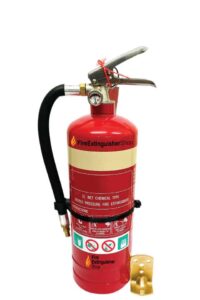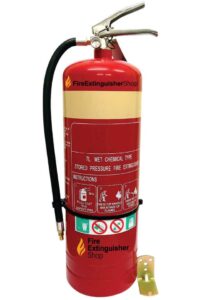Wet Chemical Fire Extinguishers
CATEGORIES
SYDNEY MELBOURNE BRISBANE $500+

Showing all 2 results
What is a Wet Chemical Fire Extinguisher?
When compared to other types of extinguishers, wet chemical fire extinguishers have a unique capacity to cope with class F flames generated by cooking oils and fats.
Wet chemical fire extinguishers are our supplier's preferred choice for class F fires, and we'll explain why in this article by looking at where they're used. We will also explain their advantages and disadvantages, and how to maintain an effective fire safety system.
What are the uses of wet chemical flame extinguishers?
Wet chemical extinguishers are intended to fight class F fires. They're ideal for kitchens that utilize oils like maize, butter, lard, and olive oil regularly.
They're ideal for fighting class A and F fires in kitchens, such as eateries, industrial, and warehouse kitchens with significant cooking and food processing sections. C02 extinguishers are also advised to be used as a precaution to battle the other types of fires to efficiently cover kitchen dangers of fire types B and E.
Fire types that are suitable for use with a wet chemical fire extinguisher
Class A - Ordinary combustibles, such as wood, paper, textiles, and various polymers, are involved in Class A fires.
Class F - Cooking fats and oils cause Class F fires, the most common. Since the temperature of these fats and oils when they catch fire is higher than that of other flammable liquids, standard extinguishers ought not to be utilized.
The Benefits of Wet Chemical Fire Extinguishers
In the case of a class F fire, wet chemical extinguishers enable rapid-fire suppression. It minimizes the possibility of the fire re-igniting by leaving a foam-like barrier.
The extinguisher's low pressure reduces the possibility of hot fats and oils splashing about. This decreases the risk of burn injuries and the spread of the fire.
It's simple to clean up after each usage.
The Drawbacks of Wet Chemical Fire Quenchers
A wet chemical fire extinguisher's fluid is alkaline, which means it might corrode certain metals.
When used, the eyes and skin may get irritating, thus it's important to clean up very afterwards.
Electrical fires should never be put out using a wet chemical fire extinguisher.
What Is The Process Of Using A Wet Chemical Fire Extinguisher?
- Ensure the extinguisher is completely charged by verifying that the pressure gauge is in the green region and that the safety pin isn't bent.
- If it's safe to do so, turn off the heat source.
- Remove the safety pin, which will break the tamper seal, while remaining a safe distance from the fire.
- Keeping the lance at arm's length, keep its nozzle at least 1 meter away from the blaze while maintaining a safe distance from the flames.
- To begin discharging the extinguisher, gently squeeze the lever.
- Apply the thin spray in gentle circular motions to enable the wet chemical agent to softly fall onto the fire area and avoid hot oils spilling onto the user.
- To guarantee that the fire has been completely extinguished, discharge the entire contents of the extinguisher. The wet chemical formula helps to prevent re-ignition.
Maintenance of the Wet Chemical Extinguisher
A fire service technician routinely inspects extinguishers every six months, as required by laws. However, once a month is the recommended time for you to guarantee the following:
- Removal of any furniture, equipment, jackets, and other items that may obstruct access to the extinguisher in an emergency are not a concern.
- The pressure is within the acceptable range, which means that the needle should be neither too high nor too low in the green zone.
- There are no obstructions to the nozzle or any other components.
- The tamper seal and pin are both intact.
- No dents, leaks, corrosion, chemical deposits, or other indicators of abuse/wear may be found. Wipe away any caustic substances, oil, grease, or other residues that have fallen on the extinguisher.
- After a certain number of years, flame extinguishers should be pressure checked (a technique known as hydrostatic testing) to confirm that the cylinder is still safe to use.
How Can You Tell If A Fire Extinguisher Is Wet Chemical?
Wet chemical fire extinguishers in Australia feature a red shell and an OATMEAL color ribbon around the tank. You may also identify a foam extinguisher by glancing at the explanation label etched on the red tank. The label should provide the following information:
Type: Wet Chemical
Size: 2.0L & 7.0L
Use Instructions
Accepted Materials For Use
The Fire Extinguisher Shop has the fire extinguishers you need for sale and is waiting for you to purchase it.
A Wet Chemical Fire Extinguisher's Working Principles
Wet chemical fire quenchers function in two ways.
First, the fire extinguisher mist reduces the temperature to a safe level, preventing the fire from spreading.
Second , in a process known as saponification, the extinguishant mixes with the heated cooking oil to generate a soapy material. The procedure cools and emulsifies a burning liquid, functioning as a boundary between the oil and fat and oxygen, dimming the flame and capping it to inhibit flame re-ignition.
You can get the best fire extinguisher price here to help you buy fire extinguishers that are enough to protect your home or business.


